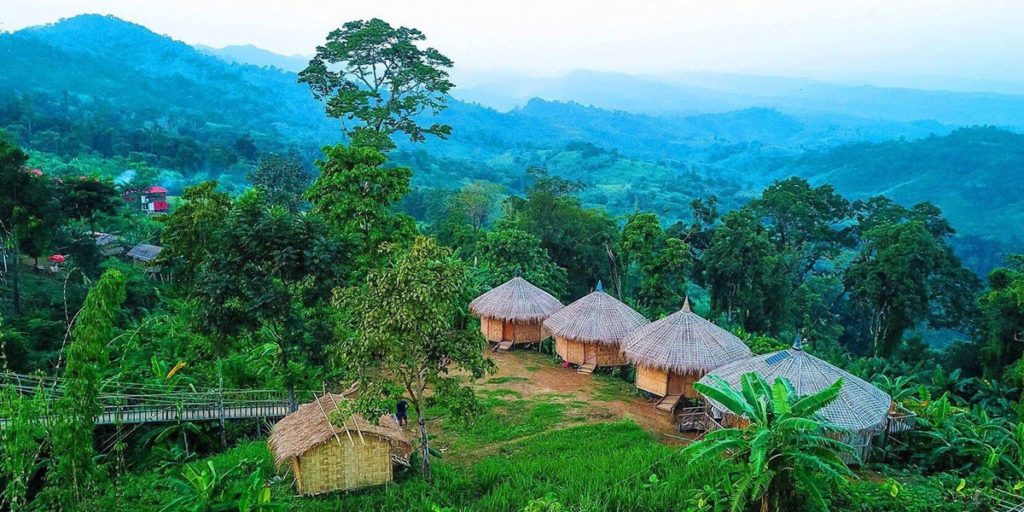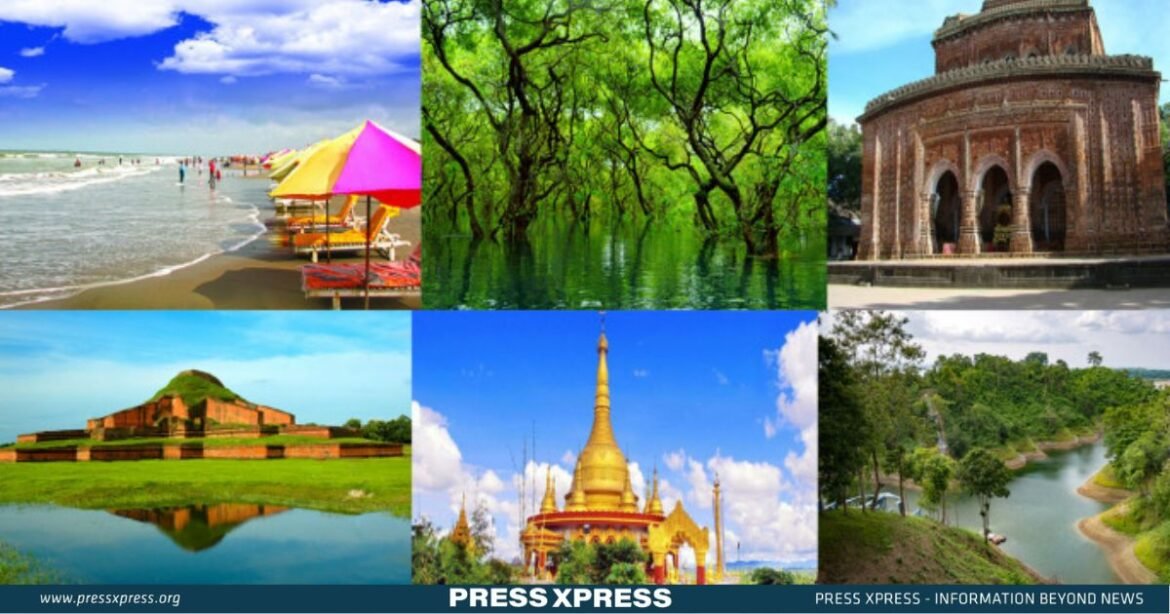Bangladesh, despite being a small country has a rich cultural heritage, diverse landscapes, and unique attractions that make it an intriguing destination for travelers seeking off-the-beaten-path experiences. Listed by the Bangladesh Parjatan Corporation (BPC), there are 1,529 tourist destinations in Bangladesh. However, many destinations remain untouched, while only a handful of spots are regularly frequented by tourists.
You can also read: E-VISAS: A GAME-CHANGER FOR TOURISM IN BANGLADESH
Bangladesh offers an array of unforgettable experiences, from exploring the Sundarban swamps on a tiger safari to embarking on a classic boat journey aboard the Rocket Steamer from Dhaka to Khulna. Additionally, navigating the bustling streets of Old Dhaka via rickshaw promises an exhilarating adventure.
The Tourism sector of Bangladesh
The tourism sector of Bangladesh is gradually gaining recognition for its diverse attractions and cultural richness. According to data from the Bangladesh Tourism Board, the country boasts a myriad of destinations ranging from the serene beauty of the Sundarbans, the world’s largest mangrove forest and home to the elusive Royal Bengal Tiger, to the ancient archaeological sites of Paharpur and Mahasthangarh. Additionally, the vibrant city life of Dhaka, with its bustling markets, historic landmarks, and eclectic cuisine, draws visitors seeking an authentic urban experience.
Despite facing challenges such as infrastructure limitations and visa complexities, Bangladesh welcomed over 5.22 lakh foreign tourists in recent years, a figure steadily rising. Efforts to enhance infrastructure, streamline visa processes, and promote cultural heritage are underway to further strengthen the tourism industry.
Most Frequently Visited Tourism Spots-
Cox’s Bazar:
The longest unbroken sandy beach in the world, the Cox’s Bazar is 125 kilometers long. The most popular tourist spot is the wholesale Fish Market which is a very interesting place to visit.

Sundarbans Mangrove Forest:
While not entirely hidden, the Sundarbans, the largest mangrove forest in the world, is often overshadowed by other attractions. It’s a UNESCO World Heritage Site and home to the Bengal tiger, making it a must-visit for nature lovers and wildlife enthusiasts.

Srimangal:
Known as the “Tea Capital” of Bangladesh, Srimangal is tucked away in the northeastern part of the country. It offers serene tea gardens, tribal villages, and opportunities for hiking through lush green hills. The Lawachara National Park for its biodiversity is also a must-visit spot.

Rangamati:
Located in the Chittagong Hill Tracts region, Rangamati is a picturesque hill town surrounded by lush green hills, Kaptai Lake, and indigenous communities. Travelers can enjoy boat rides on the lake, explore tribal culture, and indulge in activities like hiking and trekking.

Bagerhat:
This UNESCO World Heritage Site is home to the historic Mosque City of Bagerhat, which dates back to the 15th century. The city is famous for its well-preserved ancient mosques, including the Sixty Dome Mosque, showcasing exquisite Islamic architecture.

Mahasthangarh:
As one of the earliest urban archaeological sites in Bangladesh, Mahasthangarh offers a glimpse into the country’s ancient history. The ruins of the ancient city, including forts, temples, and relics date back to the 3rd century BCE is a wonderful place to visit.

Saint Martin’s Island:
Located in the Bay of Bengal, Saint Martin’s Island is the only coral island in Bangladesh. It’s renowned for its pristine beaches, crystal-clear waters, and vibrant marine life, making it an ideal spot for snorkeling and diving.

Sajek Valley:
Nestled in the hills of the Chittagong Hill Tracts, Sajek Valley offers breathtaking panoramic views of green hills, valleys, and tribal villages. It’s an emerging destination for eco-tourism and offers opportunities for trekking, camping, and experiencing indigenous culture.

Puthia:
Often referred to as the “Temple City” of Bangladesh, Puthia is home to a remarkable collection of Hindu temples and Rajbari (palaces) dating back to the 17th century. The architectural beauty and historical significance of these structures make Puthia a hidden gem for history and culture enthusiasts.

Kuakata:
Situated on the southern coast of Bangladesh, Kuakata is a tranquil beach destination offering stunning views of sunrise and sunset over the Bay of Bengal. It’s also known for its unique feature of having both sunrise and sunset visible from the same beach, making it a popular destination for nature lovers.
These hidden gems of Bangladesh tourism offer a diverse range of experiences, from cultural immersion to adventure and natural beauty, making them worth exploring for travelers seeking authentic and off-the-beaten-path destinations. Other than these places Dhaka, Barishal, Dinajpur, Sylhet, and other districts also have a lot of places to visit for tourists.

Challenges and Recommendations in the Tourism Sector
Bangladesh has a plethora of tourist attractions, ranging from ancient archaeological sites and historic mosques to the world’s longest natural beach and stunning landscapes. Its diverse offerings include lush hill forests, vibrant wildlife, and sprawling tea gardens, along with captivating tribal communities.
Visitors are often mesmerized by the country’s abundant flora and fauna and the vibrant cultural tapestry of its tribes. With each region presenting unique topography, flavors, and culinary delights, Bangladesh promises a rich and varied experience for travelers. Noteworthy features include the presence of iconic species like the Royal Bengal Tigers, the rare freshwater pink dolphins, and the ancient temples constructed from distinctive red earth.
Having such a diverse tourism sector, Bangladesh faces several challenges that hinder its growth and potential. Some of the challenges are-

Despite these challenges, the tourism sector has the potential to contribute significantly to Bangladesh’s GDP. However, it requires proper planning, budget allocation, and prioritization in national development plans. With the right strategies and improvements, the tourism sector in Bangladesh can become sustainable. To address the challenges facing the tourism sector in Bangladesh and maximize its potential, several recommendations can be considered:

The Tourism Master Plan for Bangladesh
The Bangladesh Tourism Board (BTB) has unveiled a comprehensive master plan aiming to attract 5.57 million foreign tourists yearly by 2041 and generate 21.94 million jobs within the tourism sector. The plan requires a 1.08 billion USD investment for 10 tourism clusters, with ongoing feasibility studies for five. The government will invest $105.5 million in infrastructure. Private investors will focus on luxury facilities like hotels and resorts.
Challenges include poor infrastructure, visa policies, and lack of attractions. The plan prioritizes infrastructural development, marketing, and improving service quality. It identifies 1,498 tourism resources and 14 themes for development. With 50 lakh Bangladeshis already employed in travel and hospitality, the implementation of development projects is expected to create more jobs. The master plan, prepared by IPE Global, awaits final approval from the National Tourism Council chaired by Prime Minister Sheikh Hasina. Initial steps include promoting existing tourism products and formulating policies like a homestay policy to boost community-based tourism.
Bangladesh’s tourism sector is poised for a renaissance, with its rich cultural heritage and diverse landscapes offering unique experiences to travelers. Despite facing challenges such as inadequate infrastructure and lengthy visa processing, efforts are underway to enhance the sector’s potential. The Tourism Master Plan, with its ambitious targets for attracting foreign tourists and generating employment, provides a roadmap for sustainable growth. By addressing infrastructure needs, improving safety measures, and promoting professionalism, Bangladesh can unlock its tourism potential while preserving its natural and cultural treasures. With strategic planning and collective efforts, Bangladesh can emerge as a sought-after destination for travelers seeking authentic experiences and off-the-beaten-path adventures.
Tourism and the economy of Bangladesh
Tourism can have significant impacts on the economy and GDP of Bangladesh, although the extent of these effects depends on various factors including government policies, infrastructure development, marketing efforts, and global trends. Here are some potential effects of tourism on Bangladesh’s economy and GDP:
- Contribution to GDP: Tourism directly contributes to the Gross Domestic Product (GDP) of Bangladesh through spending by domestic and international tourists on accommodations, transportation, food, shopping, and other tourism-related activities. The more tourists visit the country, the higher the contribution of tourism to the overall GDP.
- In June 2023 the tourism sector contributed slightly greater than 3 percent to the national GDP.
- Employment Generation: Tourism creates employment opportunities in various sectors such as hospitality, transportation, food services, entertainment, and retail. This is particularly beneficial for Bangladesh, where job creation is crucial for economic development and poverty reduction. The World Travel and Tourism Council (WTTC) predicted that the direct employment contribution from travel and tourism in 2024 will increase by an annual rate of 2.9%. This means it is expected to reach 1,785,000 jobs, accounting for 1.9% of total employment in 2023.
- Foreign Exchange Earnings: Tourism generates foreign exchange earnings for Bangladesh through expenditures made by international tourists. These earnings can help improve the country’s balance of payments and strengthen its foreign currency reserves. The tourism revenue of Bangladesh from tourism was 13.8 billion USD in 2023 despite jitters. The revenue was badly hampered in 2020 and 2021.
- Infrastructure Development: The growth of tourism often necessitates infrastructure development, such as the construction of hotels, resorts, transportation networks, and tourist attractions. This infrastructure not only supports the tourism industry but also benefits other sectors of the economy and enhances the overall quality of life for residents. Bangladesh ranks 109th position in the world tourism infrastructure.
- Promotion of Cultural Heritage: Bangladesh is rich in cultural heritage, historical sites, and natural attractions. Tourism can promote and preserve these assets by encouraging investment in their conservation and restoration. Additionally, tourism helps raise awareness about Bangladesh’s culture and traditions among domestic and international visitors.
- Diversification of Economy: Tourism can contribute to the diversification of Bangladesh’s economy by reducing its reliance on traditional industries such as agriculture and textiles. By developing tourism as a significant economic sector, Bangladesh can create new revenue streams and reduce vulnerability to fluctuations in other industries.
- Regional Development: Tourism has the potential to stimulate economic development in regions outside major urban centers by attracting visitors to lesser-known destinations. This can help reduce regional disparities in income and infrastructure development.
However, the magnitudes of these impacts are minimal. For instance, a one percent increase in tourism receipts increases economic growth by about 0.19 percent. On the contrary, due to a one percent decline in the tourism receipt, economic growth will decrease by about 0.66 percent.
Despite the potential, the actual contribution of the tourism industry to Bangladesh’s GDP is 1.70%, which is lower than the expected contribution of 3.20%4. This suggests that there is room for growth and development in this sector.


